Fundamentals of Cookery: Menu, Safety, and Equipment Procedures
VerifiedAdded on 2020/10/05
|28
|5910
|147
Homework Assignment
AI Summary
This comprehensive cookery assignment delves into various aspects of culinary practice, starting with considerations for compiling a dessert menu, emphasizing taste, variety, appearance, nutrition, description, and pricing. It then explores practical kitchen skills such as cleaning scales with honey, differentiating between blenders and food processors, and correctly measuring brown sugar. The assignment covers the preparation of whipped cream, the baking of orange and chocolate éclairs, and ensuring food safety in hot food display units. It also addresses procedures for receiving quiches safely, sharpening utility knives, using degreasers, and managing storage temperatures. Further topics include identifying foods requiring temperature control, distinguishing between cleaning and sanitizing, and understanding critical control points (CCPs). The assignment also covers knife safety, kitchen equipment identification, knife honing, temperature probe cleaning, and measuring various ingredients. It concludes with safety features for equipment and factors to consider when working with blenders and food processors.
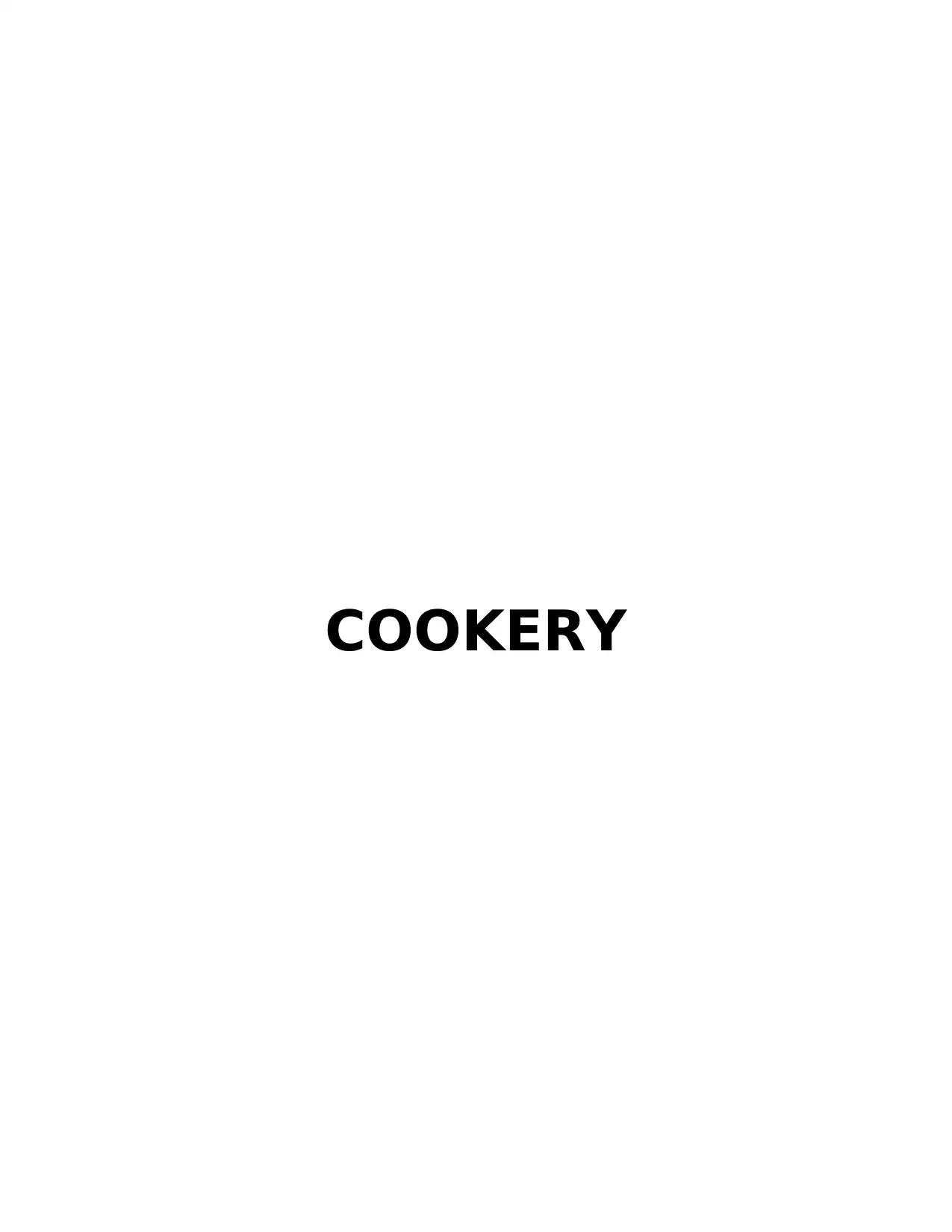
COOKERY
Paraphrase This Document
Need a fresh take? Get an instant paraphrase of this document with our AI Paraphraser
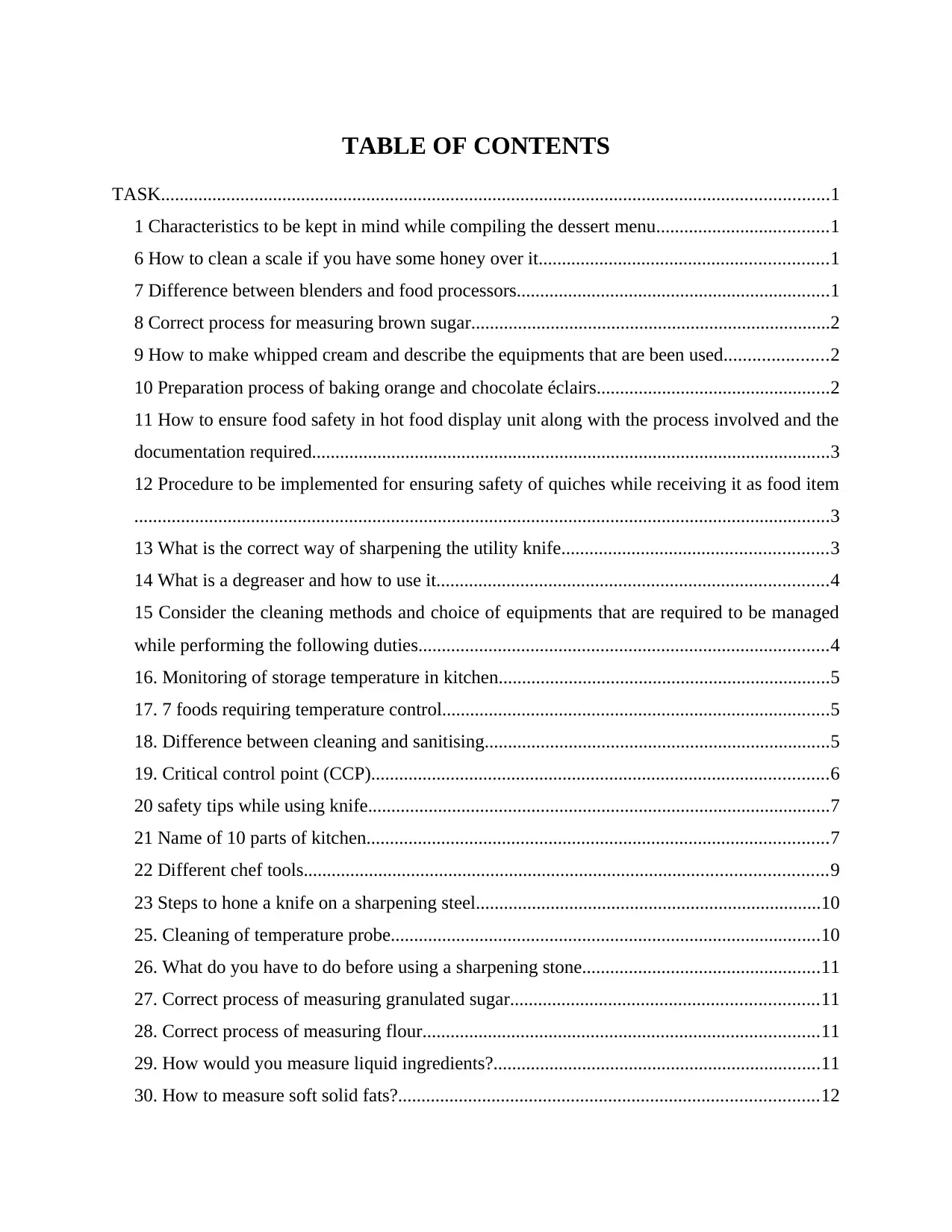
TABLE OF CONTENTS
TASK...............................................................................................................................................1
1 Characteristics to be kept in mind while compiling the dessert menu.....................................1
6 How to clean a scale if you have some honey over it..............................................................1
7 Difference between blenders and food processors...................................................................1
8 Correct process for measuring brown sugar.............................................................................2
9 How to make whipped cream and describe the equipments that are been used......................2
10 Preparation process of baking orange and chocolate éclairs..................................................2
11 How to ensure food safety in hot food display unit along with the process involved and the
documentation required...............................................................................................................3
12 Procedure to be implemented for ensuring safety of quiches while receiving it as food item
.....................................................................................................................................................3
13 What is the correct way of sharpening the utility knife.........................................................3
14 What is a degreaser and how to use it....................................................................................4
15 Consider the cleaning methods and choice of equipments that are required to be managed
while performing the following duties........................................................................................4
16. Monitoring of storage temperature in kitchen.......................................................................5
17. 7 foods requiring temperature control...................................................................................5
18. Difference between cleaning and sanitising..........................................................................5
19. Critical control point (CCP)..................................................................................................6
20 safety tips while using knife...................................................................................................7
21 Name of 10 parts of kitchen...................................................................................................7
22 Different chef tools................................................................................................................9
23 Steps to hone a knife on a sharpening steel..........................................................................10
25. Cleaning of temperature probe............................................................................................10
26. What do you have to do before using a sharpening stone...................................................11
27. Correct process of measuring granulated sugar..................................................................11
28. Correct process of measuring flour.....................................................................................11
29. How would you measure liquid ingredients?......................................................................11
30. How to measure soft solid fats?..........................................................................................12
TASK...............................................................................................................................................1
1 Characteristics to be kept in mind while compiling the dessert menu.....................................1
6 How to clean a scale if you have some honey over it..............................................................1
7 Difference between blenders and food processors...................................................................1
8 Correct process for measuring brown sugar.............................................................................2
9 How to make whipped cream and describe the equipments that are been used......................2
10 Preparation process of baking orange and chocolate éclairs..................................................2
11 How to ensure food safety in hot food display unit along with the process involved and the
documentation required...............................................................................................................3
12 Procedure to be implemented for ensuring safety of quiches while receiving it as food item
.....................................................................................................................................................3
13 What is the correct way of sharpening the utility knife.........................................................3
14 What is a degreaser and how to use it....................................................................................4
15 Consider the cleaning methods and choice of equipments that are required to be managed
while performing the following duties........................................................................................4
16. Monitoring of storage temperature in kitchen.......................................................................5
17. 7 foods requiring temperature control...................................................................................5
18. Difference between cleaning and sanitising..........................................................................5
19. Critical control point (CCP)..................................................................................................6
20 safety tips while using knife...................................................................................................7
21 Name of 10 parts of kitchen...................................................................................................7
22 Different chef tools................................................................................................................9
23 Steps to hone a knife on a sharpening steel..........................................................................10
25. Cleaning of temperature probe............................................................................................10
26. What do you have to do before using a sharpening stone...................................................11
27. Correct process of measuring granulated sugar..................................................................11
28. Correct process of measuring flour.....................................................................................11
29. How would you measure liquid ingredients?......................................................................11
30. How to measure soft solid fats?..........................................................................................12
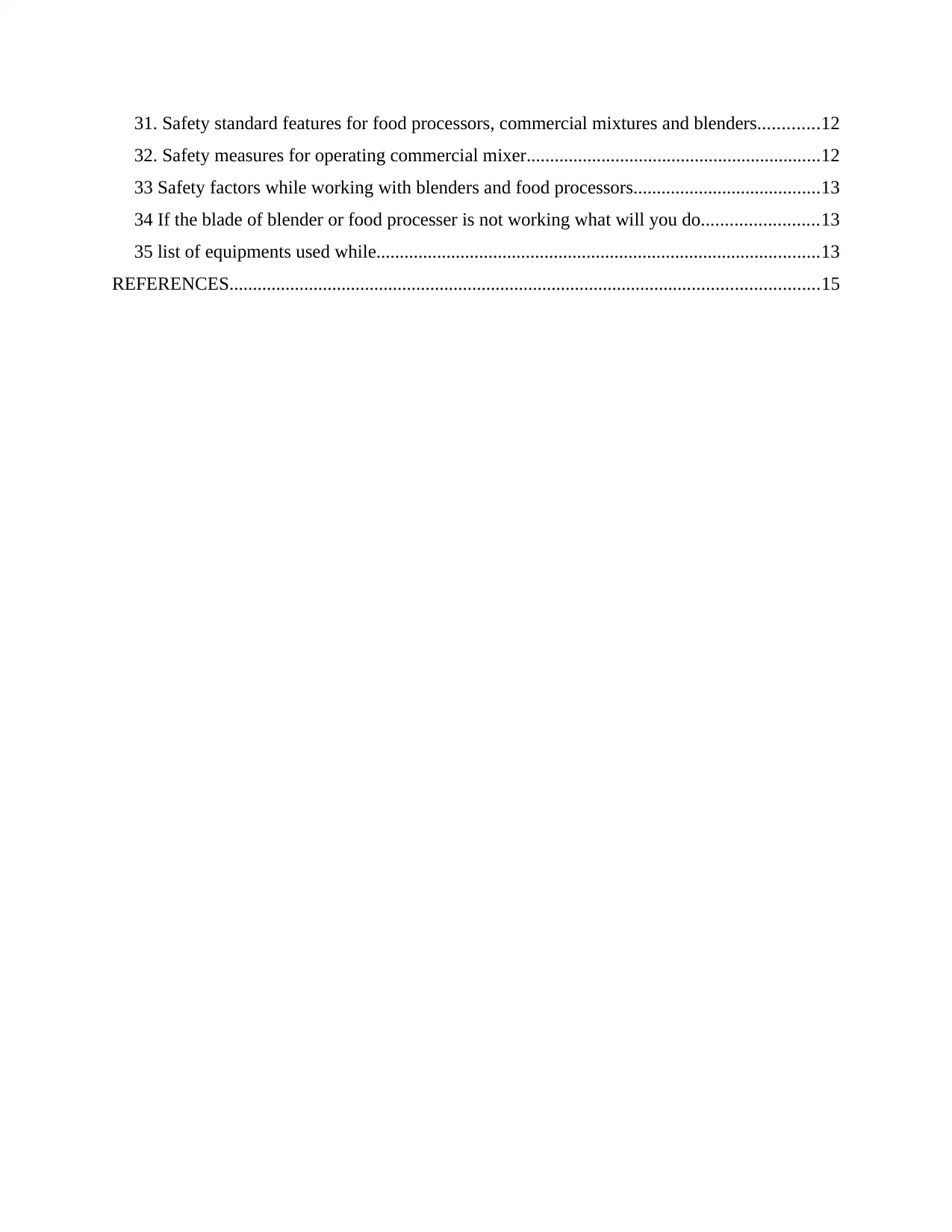
31. Safety standard features for food processors, commercial mixtures and blenders.............12
32. Safety measures for operating commercial mixer...............................................................12
33 Safety factors while working with blenders and food processors........................................13
34 If the blade of blender or food processer is not working what will you do.........................13
35 list of equipments used while...............................................................................................13
REFERENCES..............................................................................................................................15
32. Safety measures for operating commercial mixer...............................................................12
33 Safety factors while working with blenders and food processors........................................13
34 If the blade of blender or food processer is not working what will you do.........................13
35 list of equipments used while...............................................................................................13
REFERENCES..............................................................................................................................15
⊘ This is a preview!⊘
Do you want full access?
Subscribe today to unlock all pages.

Trusted by 1+ million students worldwide
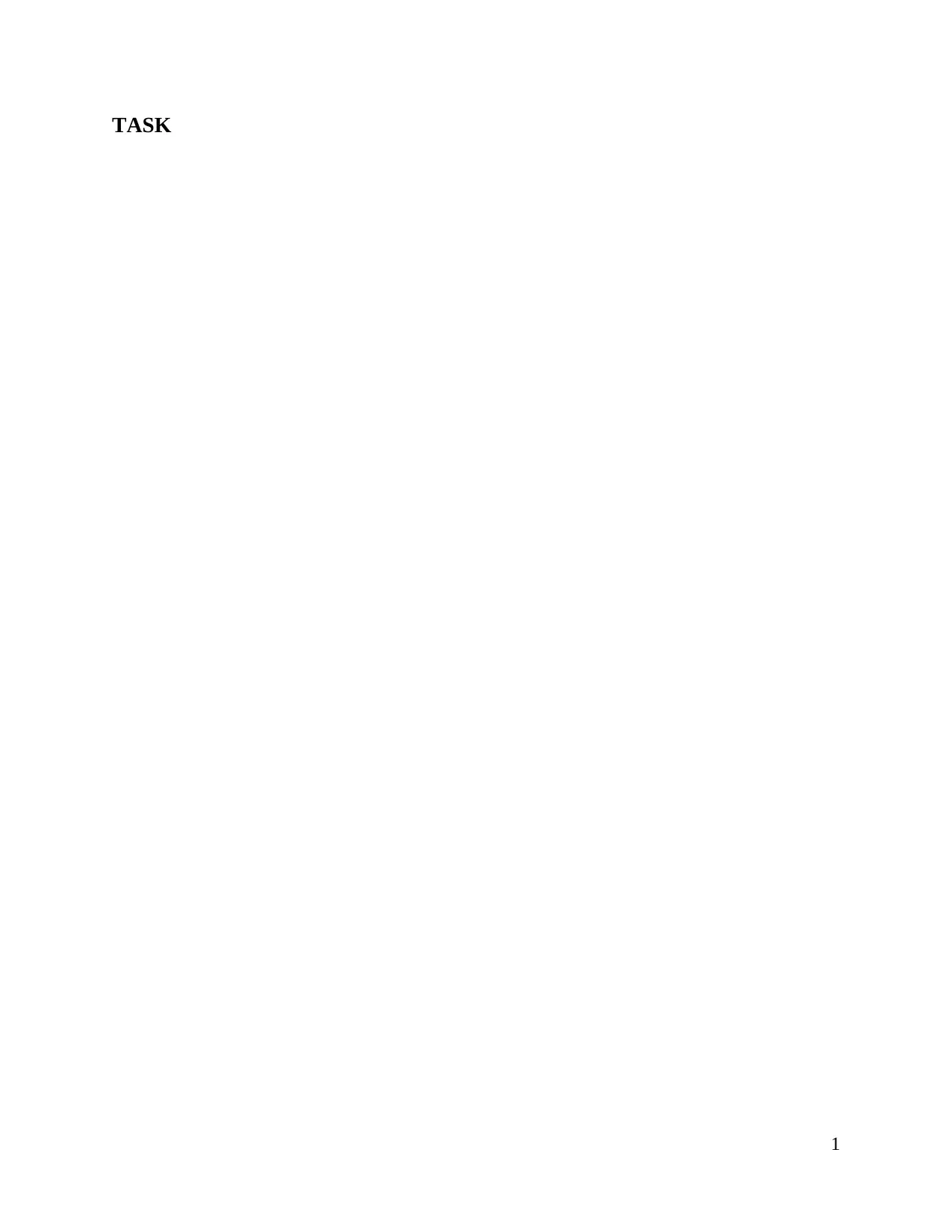
TASK
1
1
Paraphrase This Document
Need a fresh take? Get an instant paraphrase of this document with our AI Paraphraser
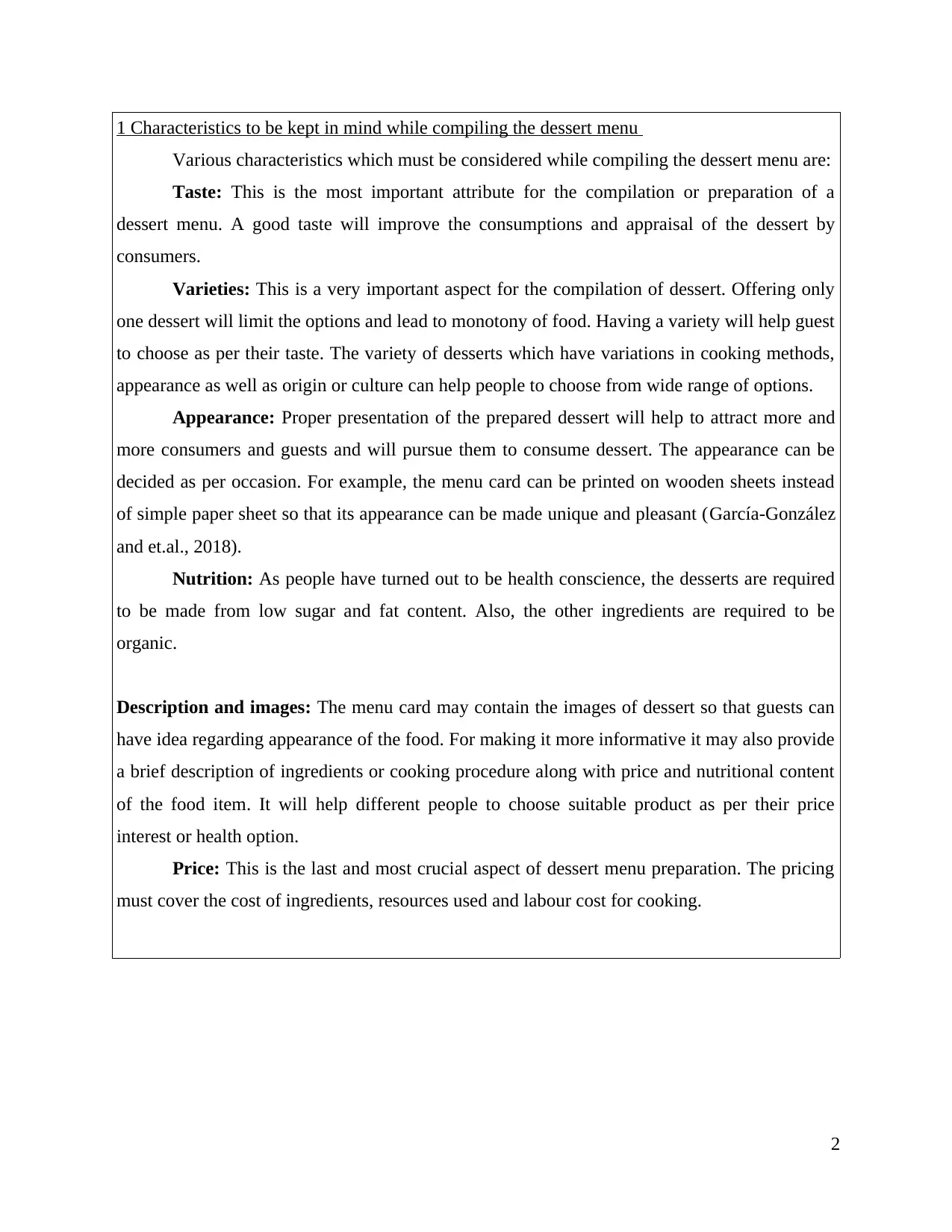
1 Characteristics to be kept in mind while compiling the dessert menu
Various characteristics which must be considered while compiling the dessert menu are:
Taste: This is the most important attribute for the compilation or preparation of a
dessert menu. A good taste will improve the consumptions and appraisal of the dessert by
consumers.
Varieties: This is a very important aspect for the compilation of dessert. Offering only
one dessert will limit the options and lead to monotony of food. Having a variety will help guest
to choose as per their taste. The variety of desserts which have variations in cooking methods,
appearance as well as origin or culture can help people to choose from wide range of options.
Appearance: Proper presentation of the prepared dessert will help to attract more and
more consumers and guests and will pursue them to consume dessert. The appearance can be
decided as per occasion. For example, the menu card can be printed on wooden sheets instead
of simple paper sheet so that its appearance can be made unique and pleasant (García-González
and et.al., 2018).
Nutrition: As people have turned out to be health conscience, the desserts are required
to be made from low sugar and fat content. Also, the other ingredients are required to be
organic.
Description and images: The menu card may contain the images of dessert so that guests can
have idea regarding appearance of the food. For making it more informative it may also provide
a brief description of ingredients or cooking procedure along with price and nutritional content
of the food item. It will help different people to choose suitable product as per their price
interest or health option.
Price: This is the last and most crucial aspect of dessert menu preparation. The pricing
must cover the cost of ingredients, resources used and labour cost for cooking.
2
Various characteristics which must be considered while compiling the dessert menu are:
Taste: This is the most important attribute for the compilation or preparation of a
dessert menu. A good taste will improve the consumptions and appraisal of the dessert by
consumers.
Varieties: This is a very important aspect for the compilation of dessert. Offering only
one dessert will limit the options and lead to monotony of food. Having a variety will help guest
to choose as per their taste. The variety of desserts which have variations in cooking methods,
appearance as well as origin or culture can help people to choose from wide range of options.
Appearance: Proper presentation of the prepared dessert will help to attract more and
more consumers and guests and will pursue them to consume dessert. The appearance can be
decided as per occasion. For example, the menu card can be printed on wooden sheets instead
of simple paper sheet so that its appearance can be made unique and pleasant (García-González
and et.al., 2018).
Nutrition: As people have turned out to be health conscience, the desserts are required
to be made from low sugar and fat content. Also, the other ingredients are required to be
organic.
Description and images: The menu card may contain the images of dessert so that guests can
have idea regarding appearance of the food. For making it more informative it may also provide
a brief description of ingredients or cooking procedure along with price and nutritional content
of the food item. It will help different people to choose suitable product as per their price
interest or health option.
Price: This is the last and most crucial aspect of dessert menu preparation. The pricing
must cover the cost of ingredients, resources used and labour cost for cooking.
2

3
⊘ This is a preview!⊘
Do you want full access?
Subscribe today to unlock all pages.

Trusted by 1+ million students worldwide
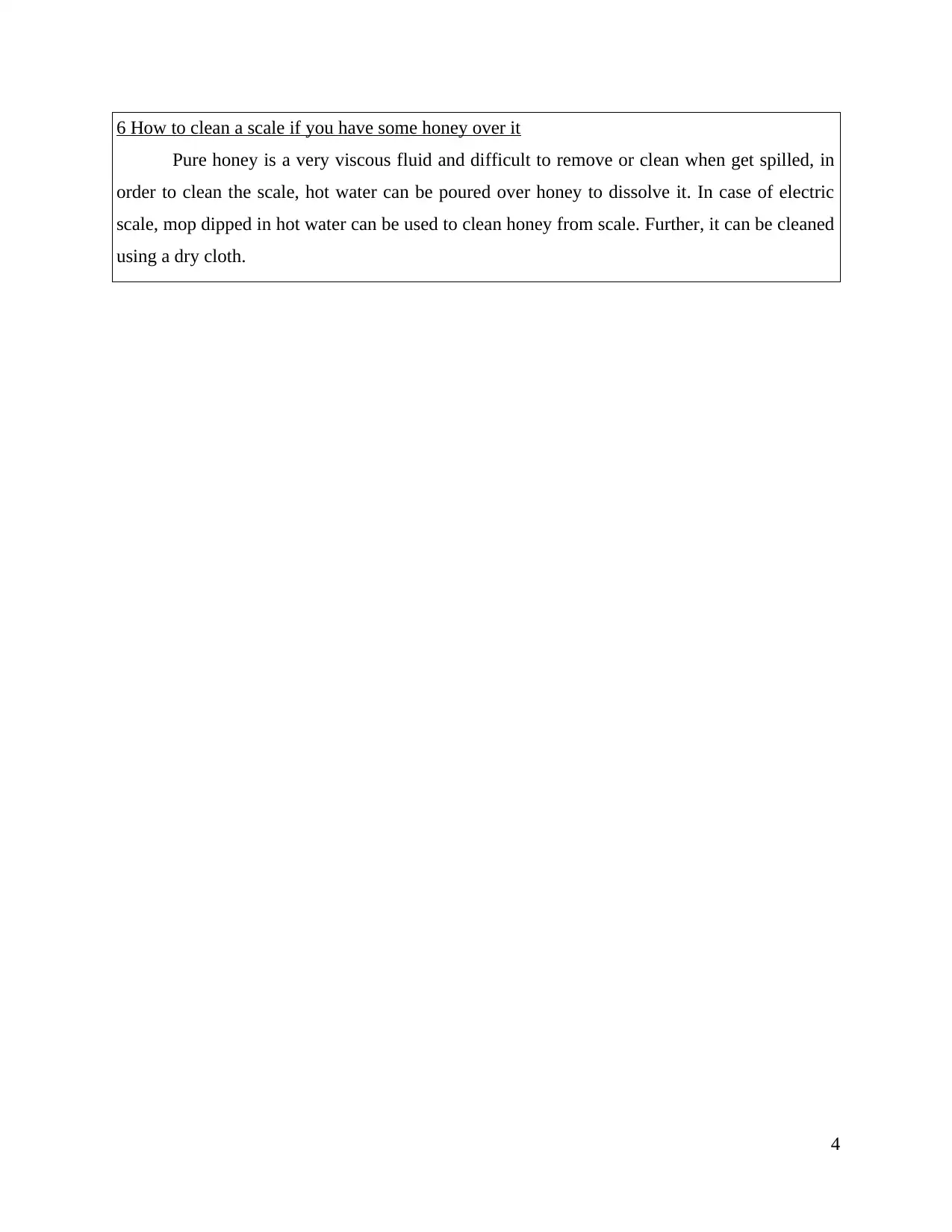
6 How to clean a scale if you have some honey over it
Pure honey is a very viscous fluid and difficult to remove or clean when get spilled, in
order to clean the scale, hot water can be poured over honey to dissolve it. In case of electric
scale, mop dipped in hot water can be used to clean honey from scale. Further, it can be cleaned
using a dry cloth.
4
Pure honey is a very viscous fluid and difficult to remove or clean when get spilled, in
order to clean the scale, hot water can be poured over honey to dissolve it. In case of electric
scale, mop dipped in hot water can be used to clean honey from scale. Further, it can be cleaned
using a dry cloth.
4
Paraphrase This Document
Need a fresh take? Get an instant paraphrase of this document with our AI Paraphraser
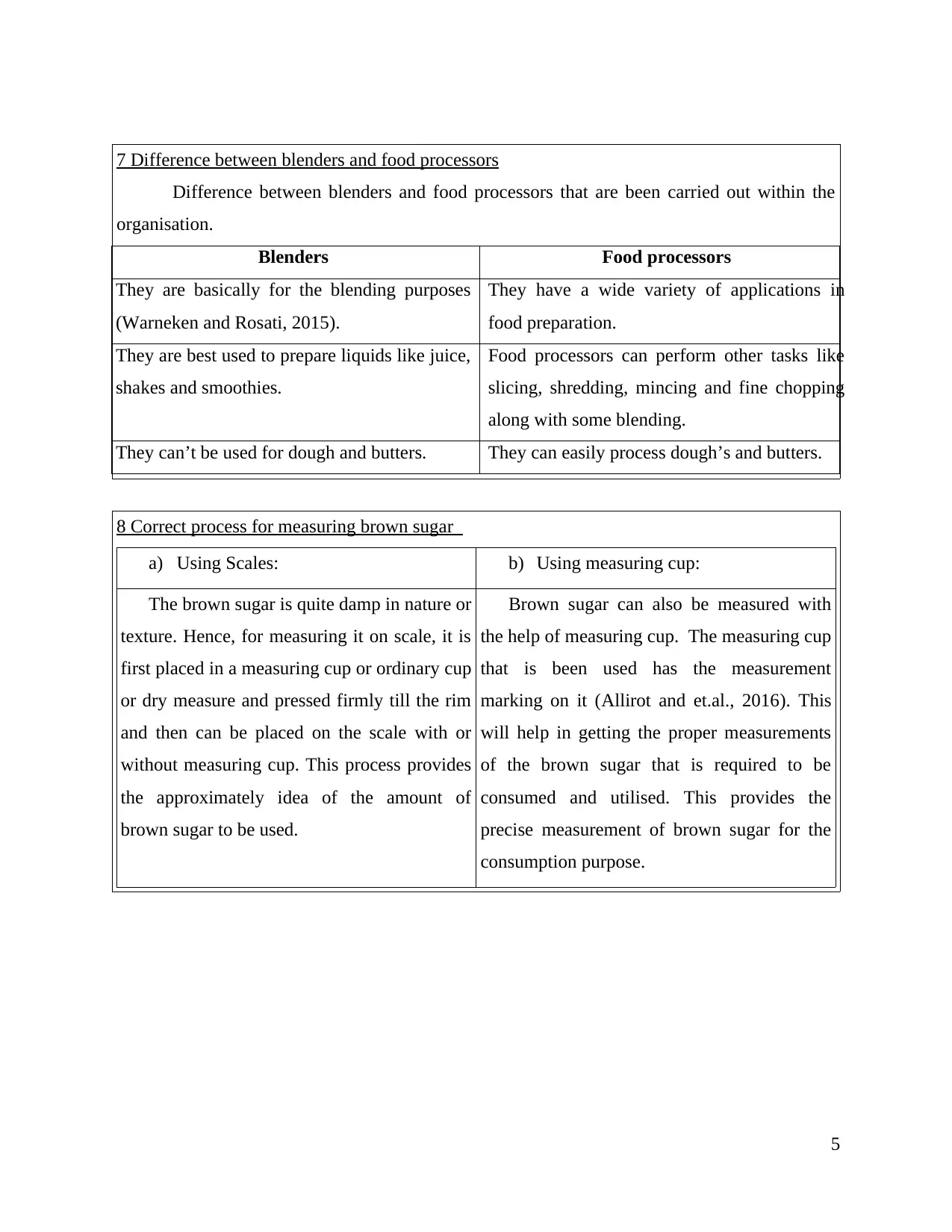
7 Difference between blenders and food processors
Difference between blenders and food processors that are been carried out within the
organisation.
Blenders Food processors
They are basically for the blending purposes
(Warneken and Rosati, 2015).
They have a wide variety of applications in
food preparation.
They are best used to prepare liquids like juice,
shakes and smoothies.
Food processors can perform other tasks like
slicing, shredding, mincing and fine chopping
along with some blending.
They can’t be used for dough and butters. They can easily process dough’s and butters.
8 Correct process for measuring brown sugar
a) Using Scales: b) Using measuring cup:
The brown sugar is quite damp in nature or
texture. Hence, for measuring it on scale, it is
first placed in a measuring cup or ordinary cup
or dry measure and pressed firmly till the rim
and then can be placed on the scale with or
without measuring cup. This process provides
the approximately idea of the amount of
brown sugar to be used.
Brown sugar can also be measured with
the help of measuring cup. The measuring cup
that is been used has the measurement
marking on it (Allirot and et.al., 2016). This
will help in getting the proper measurements
of the brown sugar that is required to be
consumed and utilised. This provides the
precise measurement of brown sugar for the
consumption purpose.
5
Difference between blenders and food processors that are been carried out within the
organisation.
Blenders Food processors
They are basically for the blending purposes
(Warneken and Rosati, 2015).
They have a wide variety of applications in
food preparation.
They are best used to prepare liquids like juice,
shakes and smoothies.
Food processors can perform other tasks like
slicing, shredding, mincing and fine chopping
along with some blending.
They can’t be used for dough and butters. They can easily process dough’s and butters.
8 Correct process for measuring brown sugar
a) Using Scales: b) Using measuring cup:
The brown sugar is quite damp in nature or
texture. Hence, for measuring it on scale, it is
first placed in a measuring cup or ordinary cup
or dry measure and pressed firmly till the rim
and then can be placed on the scale with or
without measuring cup. This process provides
the approximately idea of the amount of
brown sugar to be used.
Brown sugar can also be measured with
the help of measuring cup. The measuring cup
that is been used has the measurement
marking on it (Allirot and et.al., 2016). This
will help in getting the proper measurements
of the brown sugar that is required to be
consumed and utilised. This provides the
precise measurement of brown sugar for the
consumption purpose.
5

9 How to make whipped cream and describe the equipments that are been used
The whipped cream can be prepared by two methods: by hand whisker and by using
automated whisk. The equipment used for making whipped cream consist of a metallic mixing
bowl, cream, sugar and whisk. It consists of 3 steps to make whipped cream.
Step 1: Place the mixing bowl and whisk in freezer for 10 – 20 minutes. You can also cool
down the metallic mixing bowl using ice.
Step 2: Transfer cream from the pot to cooled mixing bowl and add sugar to it. (Refined sugar
is preferred for this process).
Step 3: Whisk it rigorously using the metallic hand whisk or automated whisk till it becomes
thick and gets stiff peaks. Once prepared, it can be stored in an air tight container for up to 10
hours in refrigerator. When required to use, take it out and re whisk for about 10-15 seconds.
10 Preparation process of baking orange and chocolate éclairs
Preheat the oven to 220° C.
Put milk, butter and water in a saucepan and boil. Off the flame and add SR flour and plain
Flour and mix it well using wooden spoon till the pastry comes away from the pan. Make
small sized buns of it.
Mix 2 eggs and blends it again. Grease the baking tray with butter, place the éclairs bun in
it and bake for 15 minutes.
Make the glaze using icing sugar, cocoa and cream. Transfer it in a hot pan and melt on a
low flame. Fill it in a piping bag and spread on the top of each éclairs.
Orange and eclairs are also added on the top of the dish before serving for making it good
in appearance.
6
The whipped cream can be prepared by two methods: by hand whisker and by using
automated whisk. The equipment used for making whipped cream consist of a metallic mixing
bowl, cream, sugar and whisk. It consists of 3 steps to make whipped cream.
Step 1: Place the mixing bowl and whisk in freezer for 10 – 20 minutes. You can also cool
down the metallic mixing bowl using ice.
Step 2: Transfer cream from the pot to cooled mixing bowl and add sugar to it. (Refined sugar
is preferred for this process).
Step 3: Whisk it rigorously using the metallic hand whisk or automated whisk till it becomes
thick and gets stiff peaks. Once prepared, it can be stored in an air tight container for up to 10
hours in refrigerator. When required to use, take it out and re whisk for about 10-15 seconds.
10 Preparation process of baking orange and chocolate éclairs
Preheat the oven to 220° C.
Put milk, butter and water in a saucepan and boil. Off the flame and add SR flour and plain
Flour and mix it well using wooden spoon till the pastry comes away from the pan. Make
small sized buns of it.
Mix 2 eggs and blends it again. Grease the baking tray with butter, place the éclairs bun in
it and bake for 15 minutes.
Make the glaze using icing sugar, cocoa and cream. Transfer it in a hot pan and melt on a
low flame. Fill it in a piping bag and spread on the top of each éclairs.
Orange and eclairs are also added on the top of the dish before serving for making it good
in appearance.
6
⊘ This is a preview!⊘
Do you want full access?
Subscribe today to unlock all pages.

Trusted by 1+ million students worldwide
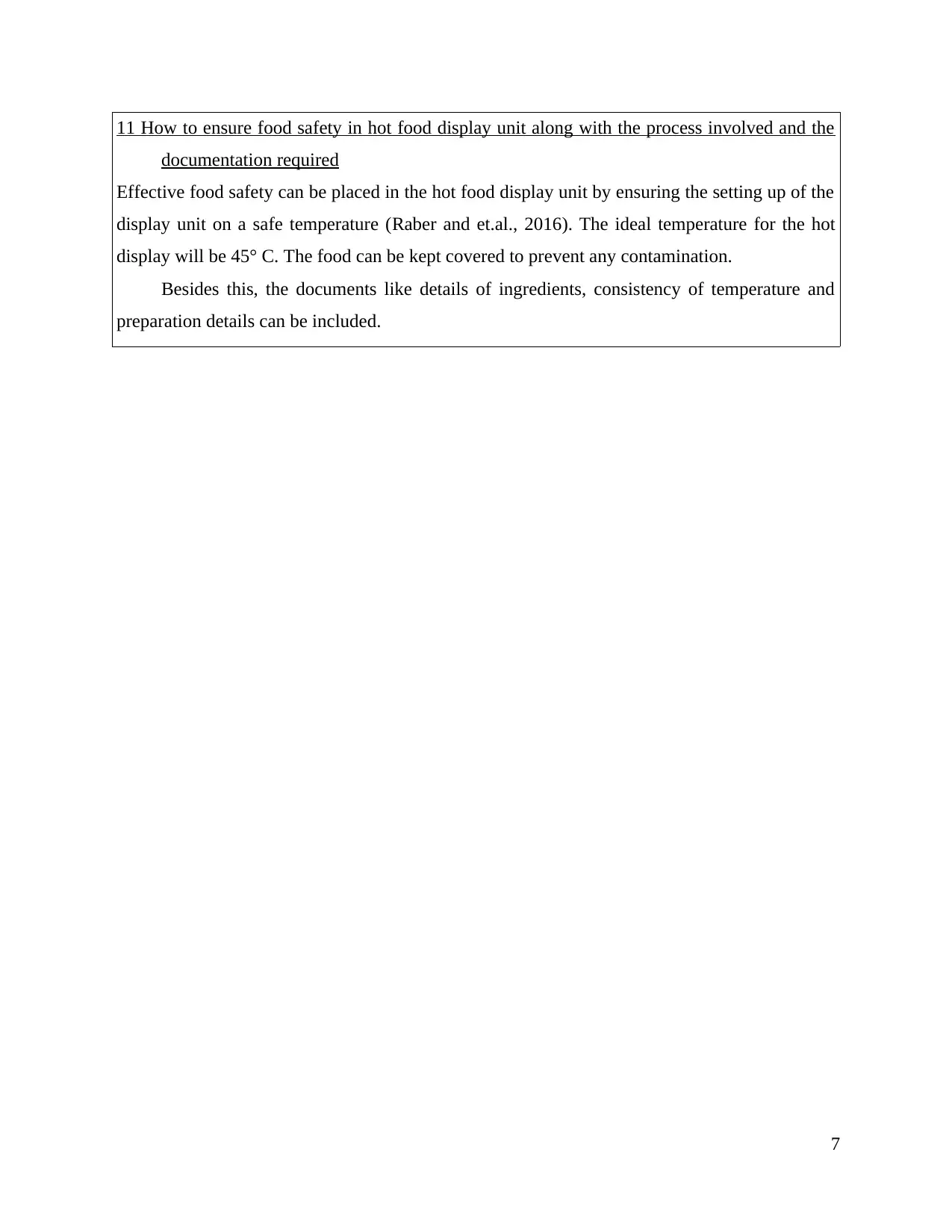
11 How to ensure food safety in hot food display unit along with the process involved and the
documentation required
Effective food safety can be placed in the hot food display unit by ensuring the setting up of the
display unit on a safe temperature (Raber and et.al., 2016). The ideal temperature for the hot
display will be 45° C. The food can be kept covered to prevent any contamination.
Besides this, the documents like details of ingredients, consistency of temperature and
preparation details can be included.
7
documentation required
Effective food safety can be placed in the hot food display unit by ensuring the setting up of the
display unit on a safe temperature (Raber and et.al., 2016). The ideal temperature for the hot
display will be 45° C. The food can be kept covered to prevent any contamination.
Besides this, the documents like details of ingredients, consistency of temperature and
preparation details can be included.
7
Paraphrase This Document
Need a fresh take? Get an instant paraphrase of this document with our AI Paraphraser

8

12 Procedure to be implemented for ensuring safety of quiches while receiving it as food item
Various procedural measures can be taken for controlling and ensuring the safety of
quiches such as:
Ensuring that the ingredients used are safe and of good quality.
The utensils and equipments that are used for preparation are thoroughly cleaned and
sanitised.
The food preparation area is free from pest and contaminants.
It is being handled and transmitted in a safe and hygienic manner.
Check the food before using or selling it to end consumers
9
Various procedural measures can be taken for controlling and ensuring the safety of
quiches such as:
Ensuring that the ingredients used are safe and of good quality.
The utensils and equipments that are used for preparation are thoroughly cleaned and
sanitised.
The food preparation area is free from pest and contaminants.
It is being handled and transmitted in a safe and hygienic manner.
Check the food before using or selling it to end consumers
9
⊘ This is a preview!⊘
Do you want full access?
Subscribe today to unlock all pages.

Trusted by 1+ million students worldwide
1 out of 28
Related Documents
Your All-in-One AI-Powered Toolkit for Academic Success.
+13062052269
info@desklib.com
Available 24*7 on WhatsApp / Email
![[object Object]](/_next/static/media/star-bottom.7253800d.svg)
Unlock your academic potential
Copyright © 2020–2025 A2Z Services. All Rights Reserved. Developed and managed by ZUCOL.


